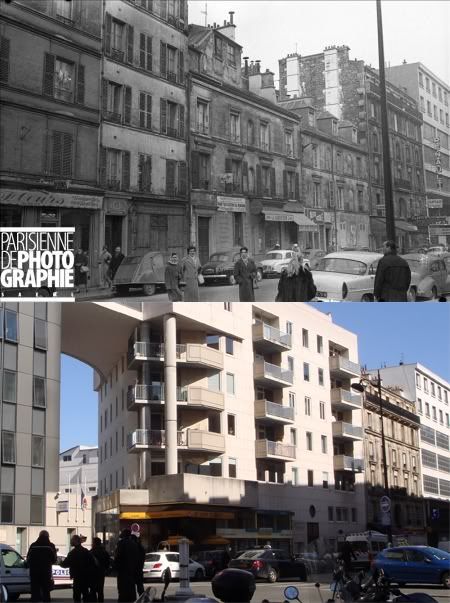Showing posts with label 15e arrondissement. Show all posts
Showing posts with label 15e arrondissement. Show all posts
Tuesday, June 2, 2009
Then and Now: 246 Rue de Vaugirard, Paris
Original photo: "Paris (XVème arr.). 246 rue de Vaugirard." Collection Roger-Viollet. Parisenimages.fr. Parisienne de Photographie. 17 Mar. 2009. http://www.parisenimages.fr/Export450/21000/20268-7.jpg
Thursday, April 30, 2009
Then and Now: 28 rue de Vaugirard, Paris
 19xx-2009
19xx-2009Mid-century planners often touted that replacing older buildings with high-rise towers would allow equal or greater population density while providing more open space at street level. This is definitely true, and there was potential to be had. Though, in many unfortunate cases like this one, that extra "open space" turned out to be completely lifeless.
Original photo: "Paris (XVème arr.). 281 rue de Vaugirard." Collection Roger-Viollet. Parisenimages.fr. Parisienne de Photographie. 17 Mar. 2009.
Tuesday, March 17, 2009
Then and Now: la place de Cambronne, Paris
Original photo: "ND-3453 Res." Collection ND/Roger-Viollet. Parisenimages.fr. Parisienne de Photographie. 17 Mar. 2009. http://www.parisenimages.fr/Export450/14000/13709-12.jpg
Tuesday, March 3, 2009
Then and Now: la gare Montparnasse, Paris

c. 1950s-2009
Source: Lefebvre, Virginie. Paris-Ville Moderne: Maine-Montparnasse et la Défense, 1950-1975. Paris: Editions Norma, 2003.The gare Montparnasse was completed in 1852 at the foot of the rue de Rennes on the site of the original gare de l'Ouest, whose capacity had been far surpassed by growing rail traffic. Nonetheless, its builders once again underestimated the amazing growth of the railroad that was to take place in the coming decades, and the station remained inadequate for much of its life, even after an expansion in the 1930s.
The three decades immediately after WWII in France was an era of gargantuan urban renewal projects, spurred by unprecedented cooperation among architects, planners, and state and city development agencies. In the early 50s, ambitious redevelopment plans were quickly put forth for the Montparnasse area calling for a new railway station flanked by multiple housing and office towers to be built above its tracks. After years of revisions, demolition and construction work began in 1961 and lasted through 1975 with the completion of the infamous Tour Montparnasse.
 The former railway station has been receded several hundred meters southward and is no longer visible in the original view, replaced by the Galeries LaFayette shopping center and the Tour Montparnasse.
The former railway station has been receded several hundred meters southward and is no longer visible in the original view, replaced by the Galeries LaFayette shopping center and the Tour Montparnasse.
Not as obvious but equally striking are the more utilitarian elements that have been added to Paris' streetscapes; long gone are days when the street consisted of little more than the sidewalk and unpainted roadway. Just about every Parisian sidewalk today is protected by metal fences, bollards, or both. Larger avenues now boast pedestrian islands, bus lanes and bike lanes, and the number of pedestrian crossings seems to have substantially increased. The sidewalks themselves are now home to bus shelters, billboards, neighborhood maps, traffic signage, and plenty of green trash receptacles. In sum, it's become near-impossible to confuse contemporary views with those of old postcard Paris.
The three decades immediately after WWII in France was an era of gargantuan urban renewal projects, spurred by unprecedented cooperation among architects, planners, and state and city development agencies. In the early 50s, ambitious redevelopment plans were quickly put forth for the Montparnasse area calling for a new railway station flanked by multiple housing and office towers to be built above its tracks. After years of revisions, demolition and construction work began in 1961 and lasted through 1975 with the completion of the infamous Tour Montparnasse.
 The former railway station has been receded several hundred meters southward and is no longer visible in the original view, replaced by the Galeries LaFayette shopping center and the Tour Montparnasse.
The former railway station has been receded several hundred meters southward and is no longer visible in the original view, replaced by the Galeries LaFayette shopping center and the Tour Montparnasse.Not as obvious but equally striking are the more utilitarian elements that have been added to Paris' streetscapes; long gone are days when the street consisted of little more than the sidewalk and unpainted roadway. Just about every Parisian sidewalk today is protected by metal fences, bollards, or both. Larger avenues now boast pedestrian islands, bus lanes and bike lanes, and the number of pedestrian crossings seems to have substantially increased. The sidewalks themselves are now home to bus shelters, billboards, neighborhood maps, traffic signage, and plenty of green trash receptacles. In sum, it's become near-impossible to confuse contemporary views with those of old postcard Paris.
Original Photo: "CAP-7676A." Collection CAP/Roger-Viollet. Parisenimages.fr. Parisienne de Photographie. 2 Mar. 2009. http://www.parisenimages.fr/Export450/8000/7355-5.jpg
Subscribe to:
Posts (Atom)

